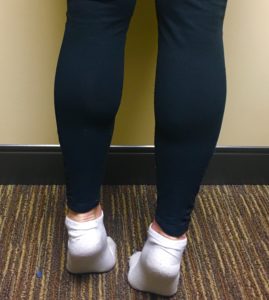Focusing on calf raises and circulation is key. And good circulation is key to protecting your vein health...and keeping ulcers at bay. When you suffer from chronic vein disease, you are vulnerable to venous leg ulcers: hard-to-heal sores that develop on your legs due to a combination of damaged capillaries and lymphatic ducts, and lack of oxygen in your lower legs. Once they develop, ulcers are hard to heal because, once again, of the shortage of oxygen reaching your lower limbs.
Fortunately, managing your vein disease with doctor-approved exercise can help protect you from developing ulcers. And, if ulcers have already formed, new evidence suggests that certain exercises may speed up your healing process! Want to know which exercises we're talking about? You may already have guessed this. But if not, we'll spell it out: calf raises and stretches!
You see, your calves are the large muscles at the back of your legs. They run from just below your knee until about halfway to your ankle. These muscles have important jobs to do. They let you move forward when you walk and run. They make sure you stay standing. And they absorb the impact of your steps. .
But they've got one more role to play when it comes to your circulation. When your calf muscles are strong, they contract with force. And that force can help push blood out of your legs and back towards your heart, making it circulate the way it's should. Now, the stronger your calf muscles, the greater the force they can offer to help your veins. Which is why making moves like calf raises and stretches can keep these muscles in top form. And may contribute to your greater overall vein health.
According to Dr. Laura Bolton, a member of the Wounds advisory board, evidence suggests that structured exercise training (SET) can help speed up the healing process for both venous leg wounds and diabetic foot ulcers. Chief among those exercises included in the SET program? Calf raises, thanks to their ability to get the heart pumping and improve circulation to the lower extremities.
In her study, 77% of patients with venous leg ulcers had completely healed after a 12-week progressive exercise program; only 53% of non-exercisers enjoyed the same result. When it came to diabetic foot wounds, individuals who exercised for just 30 of the 96-day trial window saw a dramatic result in the size of their ulcers.
In revealing her findings, Bolton said: “This suggests that the more patients engage in calf muscle exercise, the more and earlier they improve their chronic VLU or DFU healing...[This could lead to saving] limbs and lives of patients. ”
Recently, we've seen some buzzy posts calling your calf muscle a "second heart." Now, that may be a bit of an overstatement. Still, this muscle does have a big job to do: circulating blood in your lower extremities. As such, it plays an important role in blood circulation, similar to the one your heart plays for your whole body. So, just as you need to work out your heart with cardiovascular exercise, it's important to strengthen your calf muscles with workouts that will support better circulation.

While no vein disease patient should engage in a new exercise routine without a doctor's supervision, it is a good idea to discuss your physical activity once you've been diagnosed with vein health issues. Ask your doctor if it is safe to try this calf-raise routine, and you may just enjoy preventative or healing health benefits!
Standing Calf Raises
Position yourself on a staircase, with your hands resting against a wall or a sturdy object for balance and your heels hanging off the back edge of the stair. Raise your heels a few inches above the edge of the step so that you're on your tiptoes. Hold the position for a moment, and then lower your heels below the platform, feeling a stretch in your calf muscles. That's one rep; aim for three sets of 10-15 reps each. Please note that you may have to build up to that level of performance.
Prefer a move that also harnesses the benefits of walking? Try this on for size: uphill walks are especially good for your calves. But don't worry if your fitness level isn't there yet. You can still strengthen your calf muscles by walking on flat surfaces. And you don't have to set aside a big chunk of time to get these benefits. Set an alarm for every hour or two when you're at home. Then get up, walk around your house or apartment, and do a few calf raises. Throughout the day, you'll be getting a whole lot of help for your veins and circulation.
Need more help with circulation or leg ulcers? That's what we're here for. Just schedule a consultation with one of our Houston and Dallas area vein specialists. We'll set you up with a program designed to help prevent problems. Or heal any existing concerns.

Scheduling
Please contact our dedicated specialists to schedule a consultation today.
2025 Texas Endovascular. All rights reserved. Website Design by Healthcare Success